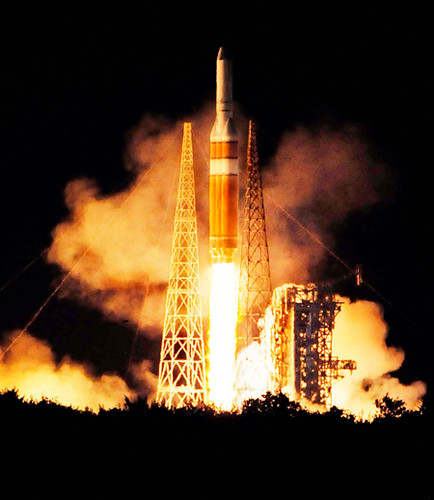Satellite Industry News Bits November 5, 2010
Loral Space and Communications may divest Space Systems/Loral satellite-manufacturing subsidiary if partially-owned Telesat pursues stock offering.
[Space News – 11/05/2010]
Azerbaijan signs deal with Arianespace to launch its first national satellite.
[Space Travel – 11/05/2010]
ITU deploys thirty broadband satellite terminals to Haiti as the country prepares for hurricane Tomas.
[TMCnet – 11/05/2010]
Comtech Telecommunications Corp. Wins $1.0 Million in Orders for On-Demand Emergency Restoral Networks.
[Sat PR News – 11/05/2010]
All systems go for launch from Vandenberg of the Delta II COSMO-SkyMed 4 (Constellation of four SAR radar satellites for global Earth Observation for the Italian Space Agency, the Minister of Defence and the Ministry of Research.
[SatNews – 11/05/2010]
Another gas leak causes another delay of space shuttle Discovery’s final launch.
[SatNews – 11/05/2010]
WiMax and Ka-band video are hottest topics at Offshore Communications 2010 show.
[Satellite Today – 11/04/2010]
SES WORLD SKIES announces renewal by Clear Channel of capacity deals for 144 MHz on four satellites to deliver connectivity and content to subscribers and audiences nationwide.
[SatNews – 11/04/2010]
Azerbaijani Communication Ministry defines company to launch first national satellite.
[TMCnet – 1/04/2010]
XTAR, LLC, first U.S. commercial provider of X-band satellite services, is awarded a bandwidth contract from Intelsat General Corporation to support military manpacks before field deployment.
[SatNews – 11/04/2010]
All systems nominal on BSAT-3b broadcasting satellite launched Oct. 28, designed and built by Lockheed Martin for Broadcasting Satellite System Corporation (B-SAT) of Japan.
[SatNews – 11/04/2010]
Hughes Network Systems successfully demonstrates 16 Mbps of TCP throughput and over 20 Mbps of UDP streaming throughput to a single HN9400 Ka-/Ku-band broadband satellite terminal.
[SatNews – 11/04/2010]
Orbit Communication Systems receives $6.25 million order to provide multiple telemetry and communications systems to an unnamed customer.
[Satellite Today – 11/04/2010]
ORBCOMM Inc.commissions South African Gateway Earth Station (GES) into operation.
[SatNews – 11/04/2010]
NASA’s FASTSAT to be launched with three other satellites aboard the Air Force Space Test Program’s STP-S26 mission from Kodiak Island Alaska November 19.
[SatNews – 11/04/2010]
Hughes Communications reports continued success of its U.S. consumer broadband business; projects 67% increase in subscribers by 2015.
[Space News – 11/04/2010]
South Africa requires all ships (including yachts) in its waters to carry an Emergency Position Indicating Radio Beacon that relays location information by satellite when ship is in distress.
[SatNews – 11/04/2010]
SES World Skies Selects ScheduAll Booking Management Solution for Worldwide booking of occasional services on its more than 25 satellites.
[Satellite today – 11/04/2010]
Intelsat S.A. and NewWave Broadband Ltd. sign a multi-transponder, multi-year contract for Ku-band capacity on two future Intelsat satellites, Intelsat 19 and Intelsat 22.
[SatNews – 11/04/2010]
Comtech EF Data acquires FX-series WAN optimization, application and platforms developer Stampede Technologies.
[Satellite Today – 11/04/2010]
In wake of the loss of its new W3B satellite shortly after launch, Eutelsat is cheered by rise in revenue.
[Broadband TV News – 11/03/2010]
Worldwide interference geolocation services contract awarded to Integral Systems by U.S. Strategic Command.
[Market Watch – 11/03/2010]
Astrium celebrates 20 years of Eurostar satellite production and accumulation of 370 years of in-orbit operation by 45 satellites that have been launched.
[Web Wire – 11/03/2010]
MTN Satellite Communications (MTN) equips Burger Boat with communication suite including onboard medical treatment facility with 24/7 video conferencing capability.
[Satellite Today – 11/03/2010]
RigNet Wins VSAT Contract from SandRidge Energy for fully-managed remote communications to more than 20 land-drilling rigs in U.S.
[Satellite Today – 11/03/2010]
Vizada releases Universal Card solution for prepaid calling on Inmarsat’s IsatPhone Pro.
[Satellite Today – 11/03/2010]
Russian military communications satellite launched on a Soyuz rocket from the Plesetsk Cosmodrome in northern Russia.
[Spaceflight Now – 11/02/2010]
Delta II’s final scheduled commercial launch is struggling to get off the ground, after scrubbing for the third time in a row on Tuesday night.
[NASA Spaceflight – 11/02/2010]
ITU installs 100 satellite terminals to get links to flood-ravaged regions of Pakistan.
[eWeekEurope – 11/02/2010]
Globecomm Systems receives contract from a major media & entertainment company valued at $3.8 million.
[TMCnet – 11/02/2010]
ViaSat demonstrates full mesh HD video between mobile satellite terminals on Optus C1 satellite using Ausatralian-designed antenna.
[TWire – 11/02/2010]
Viasat completes operational testing of airborne intelligence, surveillance, and reconnaissance (ISR) satcom system with 4Mbps return link from plane.
[TMCnet – 11/02/2010]
Xinhua reports that China has launched a new metorological satellite, Fengyun-3, from the Taiyuan Satellite Launch Center in northern China.
[SatNews – 11/01/2010]
Hughes Network Systems’ HX wideband global SATCOM solution undergoes certification by U.S. Strategic Command SATCOM Systems Expert.
[PRNewswire – 11/01/2010]
Amid criticism, Egypt orders reissuing of TV satellite uplink licenses ahead of November vote.
[Washington Examiner – 11/01/2010]
The government and military market remains sustainable and continues to exhibit growth despite changes in policy from the United States and allied governments, particularly in Iraq.
[NSR Report – November 2010]
WBMSAT PS satellite communications systems services









